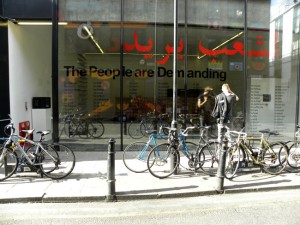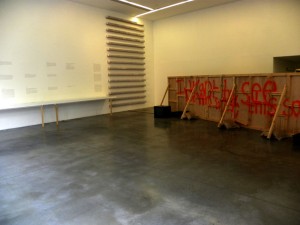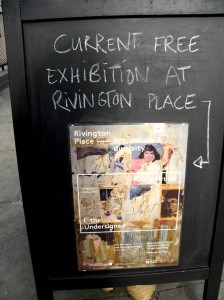RABIH MROUḖ at INIVA London
Rabih Mroué─The People are Demanding
Rabih Mroué withdrew a work from his one person exhibition at INIVA in London, and left this label instead.
“The work I, the Undersigned” was supposed to be here. It is an installation which consists of two monitors and one wall text that draws attention to the intentional disregard of those responsible for the Lebanese civil wars and their refusal to give any apology to their people for all that they committed during the wars ( 1975 -1990) Beside this text one monitor shows my personal apologies for what I did during those years, and another monitor shows my face staring at you.
“I decided not to show this work today due to the radical changes, struggles, conflicts, revolutions and turmoil of a geopolitical and sociopolitical nature that are going on in my region. These changes pushed me to change the title of this exhibition from “I the undersigned” to “The People are Demanding “ From “I” to “We” as I believe that I belong to the people. But “I” seems to me not to be changing while “We” is changing very fast. Between that “I” and this “We” there is a big red question mark. ”
In the window of the exhibition is a series of verbs, extracted from the statements of protestors , lines and lines of verbs ,”to switch, to itch, to pitch, to gain, to win, to pin, to sin, to sight, to light, to smoke, to consume, to conserve, to feast, to enjoy, to demolish, to possess, to wipe, to escape, to flee, to clear, to know, to gossip, to whisper, to sneak, to seek, to yell, to turn, to overturn, to stop, to finish, to reborn, to do, to undo, to redo, to fail, to nail, to past, to last, to ice, to dice,” are the last two of eight columns of verbs.
So the verbs are the demands, but they are also acts, as we have seen in the last few months. We don’t know where these verbs will lead, but that moment of speaking and demanding is the foundation of this exhibition.
In the exhibition itself are four other works. Old House, 2003, On Three Posters, Reflections on a video-performance, 2004, and two new installations, Je Veux Voir, 2010 and Grandfather, Father and Son, 2010. Finally there is a piece inspired by Rabih Mroué’s way of working from fragments of serendipitous archives called “Possible Damage: The Inivators in collaboration with Tania El Khoury,”that constructs the student protests in London in the spring of 2011 against tuition increases, with fragments, arbitrary objects found at the time, the detritus of protest, like a fire extinguisher and a pair of googles, and blurry images of three protestors who disappeared.
So where does this exhibition fit in the work that I have written about before by Rabih Mroué, most notably his live performance at Lift Theater in 2004 “Looking for a Missing Employee” which I also discuss in my book Art and Politics Now, Midmarch Arts Press, 2011, and at Oxford in 2006 “Make Me Stop Smoking.”
Mroué is still dominant in all the works and, except in the work in the window of INIVA, We the People Demand, his presence is strong as a narrator, as a subject. He deconstructs what he is doing as he presents, always analyzing, self aware, contextualized within his own work. In the earliest work in the exhibition, Old House 2003 a video shows over and over the destruction of a building and in reverse, its return to normal. Mroué declares in a similarly looped idea: “I invent what I have forgotten on the basis that I have remembered it. After an indefinite time, I retell it to make sure I have forgotten. .. I ‘m betting on death in order to rediscover everything anew.”
On Three Posters, Reflections on a video-performance, 2004, is an analysis of a suicide bomber’s video as well as an analysis of his own actions in incorporating it into a performance piece of his own, On Three Posters in collaboration with Elias Khoury in 2000. The source video was made by a leftist martyr. He did three takes, and Mroue’s long analysis considers those three takes as identifying himself as actor, martyr and politician. Mroué wonders why he did three takes, whether he thought about how he presented himself in the three takes, what were the suicide bomber’s motivations for “getting it right”. Did it suggest hesitation, or self consciousness, or self reflexivity? Then Mroué wonders if he was exploiting him in including his video in his own performance art, would the suicide bomber wanted his video to be used in that way?
In the new installation, Grandfather, Father, Son, the artist presented the index cards of his grandfather’s card catalog for his library.They have become meaningless, without categories, just markers of an obsolete systemizing. His grandfather was a religious scholar then a Communist and the author of a book on “dialectics in Islam.” “He was assassinated when starting to work on its third volume”. Also included are manuscript pages of the never published mathematical treatise on the Fibonacci series written by his father during 1982, the year of the Israeli occupation of Lebanon and the height of the civil war. The intense abstraction of mathematical analysis in the midst of war suggests the key to why Mroué is so self aware. He understands the terror of bombs falling on his own home, and killing members of his family, but he is part of an intensely intellectual family that can see their personal disaster in a larger context, and can consciously reject or embrace pieces of that bigger picture.
Finally there is a short story that the artist wrote in 1989 that was published in a Communist newspaper. The story has eerie premonitions of what actually befell his family. The artist reads the short story in 2010 sitting directly in front of and close to the camera in his grandfather’s library.
Another new piece Je Veux Voir [ I want to See] ( 2010) also refers both directly and indirectly to his own family’s experience in the midst of war. On a large freestanding two sided billboard, he includes photographs of old posters and graffiti from Bint Jbeil, the destroyed village from which his family came, The graffiti imagery, and elusive code numbers, as well as an excerpt from a film of the same title made by Joanna Hadjithomas and Khalil Joreige in which he and Catherine Deneuve walk around the destruction of the village. The gallery is filled with her repeated call for him. In the film she calls only a couple of times and he answers)
It is just a brief moment of a fairly long film during which she and Mroué as her chauffeur have various situations to deal with, stopping the car in a forbidden place, taking a wrong turn on a road that is landmined, walking on a short road near the Israeli border, with their military vehicles driving by in the distance and finally, the loud noise of Israeli airplanes on simulated attacks. Cumulatively we can experience the increasing sense of oppression, anxiety and threat. When they actually reach the village, the reality of destruction seen in the film, the reality of loss, is constructed from pieces that do not describe, but actually tell us that what is lost is gone and cannot be brought back. Mroué cannot even find where his grandmother’s house was, although he spent many summers there as a child.
Mroué is always provocative: drawing on theater, film, television, his deliberately deadpan persona dramatizes his Brechtian use of real life and real people, people that in the new works in this exhibition are himself and his family, his village, and his city.
That Brechtian awareness led him to move from I to We in this exhibition, recognizing the obsolescence of the I in the current political climate. “We the People are Demanding “responds to the new realities of the Arab world, the awakening of youth throughout so many countries, the new aspirations, the new slogans, and new desires being openly expressed. It gives this exhibition a different flavor entirely. It speaks directly from the “we” of now. The installation by the Inivators also speaks to that now.
In expanding his art to embrace the “we”, Mroué’s detachment, and even his own personal suffering are deeply altered. It is as though he has joined the world, the world of the Arab spring.
For a description of the piece omitted from the exhibition, which was shown in Utrecht from April to August 2010, see here.
Bonus Section:
I wrote about his performance in Oxford Make Me Stop Smoking in 2006, it was cut from my book, so I include it here.
Rabih Mroué’s performance in Oxford, “Make Me Stop Smoking,” addressed the artificial constructions of art production as well as history. Mroué began with titles, and the Arabic saying “a letter is understood by its title” He declared that he collected titles that were “light, but intellectual” “deep, but catchy”, an amusing analysis of a process that most artists either dismiss (with untitled) or take perhaps too seriously. Titles, for everyone but artists, are usually enormously overvalued, so Mroué’s collecting of titles that have no relationship to a work is particularly appealing as an entree into his work “Make Me Stop Smoking.” That title is either deep and catchy or irrelevant. Smoking in the context of his work is an addiction, it might be said, to collecting information of all sorts.
Mroué has collected and preserved news clippings about historical, scientific, anthroplogical or any random event, video clips of news events, television programs, rehearsal tapes of martyr videos, photographic projects ( for example photographing sewer covers), all fragments which he described as “material from the past, waiting to be used in the future.” In “Make Me Stop Smoking,” he declared he wished to rid himself of the “burden” of his non personal archives. (he also has archives of his proposals, press clippings, and documentation of his own projects).
The performance is stated to be a way to leave behind obsessions with information that has no purpose, by acknowledging that it has no meaning, no historical anchor, nor significance, because of collective amnesia. In “Make Me Stop Smoking”, Mroué himself is the main subject, instead of a person he tries to construct from an archive. He becomes the main character, his own acts are suspect and useless, as he “reinvents what he has forgotten on the basis that he happens to remember it, betting on Death to rediscover everything new.” It is a plea, in other words, to himself that he stop obsessing about past history. His conclusion, a setting of six empty frames through which he climbs in an endless and meaningless succession, suggests the entrapment he feels in his own systems of ordering.
This entry was posted on June 13, 2011 and is filed under Art in Beirut, Rabih Mroué.











